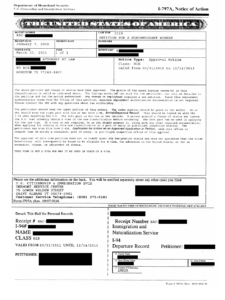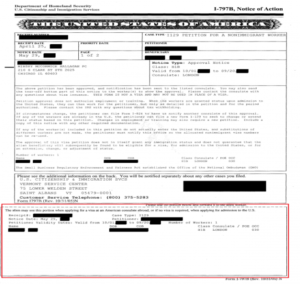
A Human Resource Perspective of an Employee Changing Immigration Status
As we move closer to October 1, many employees across the United States will be changing their immigration status to H-1B. At times, this may mean that the employee will begin working for a company for a first time. However, many times, the employee is currently employed by the company and will be changing their status to H-1B from a variety of other immigration statuses including F-1, H-4 EAD, or L-1. This article will focus mainly on the change of status of an employee who is currently an employee of a company that will be changing his immigration status. Please note that this article will address certain obligations from a general perspective and will not address the various state employment law concerns.
As a practical matter, October 1 is the first possible date an employee can begin working on a new H-1B that was subject to the H-1B cap. This October 1 date is not automatic however. The employee must have an approved I-797 H-1B for your company with a valid I-94 before they start working on H-1B status. Below are two samples of an I-797. The I-797 on the left is a case where the petition was approved with an I-94. The I-797 on the right is a case where the petition was approved without an I-94.
If a case is approved without an I-94, the employee must return to his home country, get a new H-1B visa stamp, and then reenter the United States before he can begin working on H-1B status. If the employee has a valid I-94 attached to their I-797, or has gone for stamping, he can begin working on October 1 or upon approval, whichever is later. At this time, there are three major areas HR personnel must be aware of once the H-1B takes effect: 1) salary of the employee and other Labor Condition Application (LCA) obligations; 2) I-9 verification; and 3) tax obligations of the company.
Salary of the Employee and Other LCA Obligations
When a company files for an H-1B, the H-1B is supported by an LCA that has the company attesting to certain standards to which it will adhere. While there are many LCA obligations that must be met to comply with H-1B and DOL regulations, the focus of this article will be on HR type obligations.
One of the biggest obligations the company must meet is the payment of wages as noted on the LCA. This salary may be different from what the company is currently paying the employee in their current capacity and is often a higher salary. As soon as the employee begins working for a company in H-1B capacity, the company must adjust payroll to account for the LCA salary. Failure to pay wages in accordance with the LCA is a Department of Labor violation which could cause issues with the company.
In addition to salary, H-1B workers must be provided with the same benefits as similarly employed U.S. Workers. Per DOL guidance benefits include the opportunity to participate in programs such as, health, life, disability, and other insurance plans, retirement and savings plans, cash bonuses, and non-cash compensation such as stock options. If the company provides full health insurance coverage, 401k matching, and stock options to US workers, they must also provide it for similarly employed H-1B workers.
While this article is intended to focus on the employment of H-1B workers, it is important for HR professionals to understand what needs to happen to properly terminate an H-1B employee if necessary. Companies that employ H-1B workers need to keep in mind that termination of an H-1B employee is more complex than US workers. The DOL has held that the company is still liable for all LCA obligations, including salary, until there is a bona fide termination of the H-1B employee. In order to have a bona fide termination, the company must complete three steps. First, they must expressly terminate the H-1B employee. This is preferably done in writing to allow for record keeping. Second, the company must notify USCIS of the termination. This can be done in the form of a letter requesting to withdraw the H-1B approval. Finally, companies terminating an H-1B employee must offer to pay for the return flight home. This can be done in writing with the express termination letter. If the employee decides to return to his home country, the company must pay for the expenses of the return.
As noted above there are other obligations that must be met to maintain compliance with the H-1B and DOL regulations and guidance. This article is intended only to discuss the initial hiring, and if necessary firing, of an H-1B employee.
I-9 Verification
When a previous work authorization document expires, the company must re-verify the employee’s employment eligibility. Please note that this reverification process must only take place once the current employment authorization document expires. For example, if a student has STEM OPT valid until 05/01/2020 and changes status to H-1B on 10/1/2018, you do not have to do reverification until 05/01/2020. This presents a tricky situation for a company when an employee changes his status to H-1B. If a company does it earlier, it could be considered a discriminatory practice, which could be an issue. Companies must reverify the employment authorization no later than the date the employment authorization expires.
Section 3 of the I-9 form should be used for any updating and reverification. This section of the I-9 form has many uses. It can be used when there is an employee name change, the rehiring of a previous employee, or for changes in the work authorization. The first step in reverifying an I-9 is to collect and inspect the new documents. While companies cannot tell employees what is required, for immigration purposes employees often provide their new I-94 with their passport. This is document 5 in List A of the current I-9. In order to update it for a change in the employment authorization document, companies must first take the name from section 1 of the I-9, unless there is a change, enter it as last name, first name, and middle initial. From there you will put in the date of rehire if applicable. Finally, companies will complete part C. of Section 3 entering in the new document title, document number, and the expiration date.
There is often confusion as to whether there has been a rehire. If the employee has work authorization valid at the time of the approval and change of status, there would not be a rehire. For example, if the employee is on F-1 STEM OPT or H-4 EAD that expires on 03/05/2020, and the change of status is approved on or before 10/01/2018, there would not be a rehire. The company would just have to do reverification on 03/05/2020 with the newest work authorization document. However, if the employee is on cap-gap, which always ends on September 30 of each year, and the H-1B is not approved until after October 1, the company would need to rehire the employee along with doing a reverification.
For example, if the employee has F-1 STEM OPT valid until 06/20/2018 and his cap subject H-1B change of status is selected and pending, he can remain on cap-gap until 09/30/2018. If the H-1B is not approved by that time, the company must terminate the employee and wait until the H-1B is approved to rehire. So for purposes of this example, if the H-1B is approved on 11/01/2018, at that time the company can rehire the employee and would have to do reverification of the I-9.
As a reminder, all I-9 reverifications must happen no later than the day the current employment authorization expires. It is recommended that HR professionals keep a document with all employment authorization expiration dates and set calendar alerts so they do not lose track.
Tax Implications of F-1 to H-1B Change of Status
Many H-1B change of status cases are requesting a change of status for F-1 students that are working pursuant to their OPT. There are different tax implications of employing F-1 OPT employees compared to employing H-1B employees.
Aliens temporarily present in the United States as students are subject to special rules with respect to the taxation of their income. F-1 students also are in this category and are therefore exempt from paying U.S. Social Security and Medicare taxes out of their income. Companies need to be aware that they must update their payroll to account for the change of status. Once the employee changes status to H-1B, payroll needs to be updated to withhold money for Social Security and Medicare taxes starting as soon as the change of status is effective.
While these are just some of the HR considerations that must come with an employee changing status, this provides a good overview of often overlooked areas of having a new H-1B employee.
By Steven Brown
Steven Brown is an attorney in the firm’s H-1B Department and represents our business clients throughout the entire H-1B, H-4, and H-4 EAD process. Additionally, Steven works with clients with Department of Labor Compliance included assistance with wage and hours investigations. Steven prides himself in being able to provide his clients with creative solutions to complex immigration problems.



